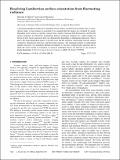Resolving Lambertian surface orientation from fluctuating radiance
Author(s)
Makris, Nicholas; Bertsatos, Ioannis
Downloadresolving_lambertian JASA_2011.pdf (429.0Kb)
PUBLISHER_POLICY
Publisher Policy
Article is made available in accordance with the publisher's policy and may be subject to US copyright law. Please refer to the publisher's site for terms of use.
Terms of use
Metadata
Show full item recordAbstract
A maximum likelihood method for estimating remote surface orientation from multi-static acoustic, optical, radar, or laser images is presented. It is assumed that the images are corrupted by signal-dependent noise, known as speckle, arising from complex Gaussian field fluctuations, and that the surface properties are effectively Lambertian. Surface orientation estimates for a single sample are shown to have biases and errors that vary dramatically depending on illumination direction. This is due to the signal-dependent nature of specklenoise and the nonlinear relationship between surface orientation, illumination direction, and fluctuating radiance. The minimum number of independent samples necessary for maximum likelihood estimates to become asymptotically unbiased and to attain the lower bound on resolution of classical estimation theory are derived, as are practical design thresholds.
Date issued
2011-03Department
Massachusetts Institute of Technology. Department of Mechanical EngineeringJournal
Journal of the Acoustical Society of America
Publisher
American Institute of Physics
Citation
Makris, Nicholas C., and Ioannis Bertsatos. “Resolving Lambertian Surface Orientation from Fluctuating Radiance.” The Journal of the Acoustical Society of America 130, no. 3 (2011): 1222. © 2011 American Institute of Physics.
Version: Final published version
ISSN
00014966